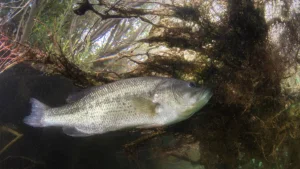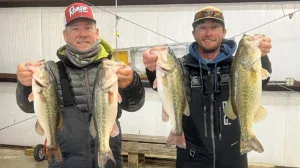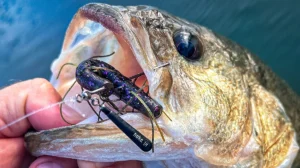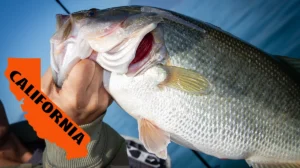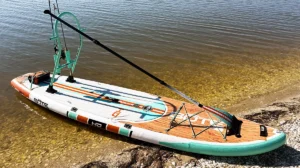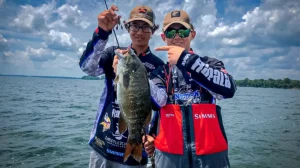Dock skipping lures is a must-know technique for all serious bass anglers. Gerald “GMAN” Swindle is a master among masters. He teaches the art of dock skipping in this ultra-informative video covering proper form and body mechanics, rod setup and tackle considerations, and boat positioning guidance.
SWINDLE’S PERFECT JIG SKIPPING SETUP
- JIG – Buckeye Lures G-Man Ballin’ Out Jig, 3/8-ounce
- TRAILER – Zoom Z Hog
- ROD – 13 Fishing Envy 3 Casting Rod, 7’3″ MH
- ROD (alternate) – 13 Fishing Omen Black 3 Casting Rod, 7’1” MH
- REEL – 13 Fishing Concept A2, 6.8:1
- LINE – Sunline Shooter Fluorocarbon, 16- to 18-pound
- SUNGLASSES – Costa Del Mar Reefton
Swindle’s dock skipping tip list (in no particular order):
- Don’t rush the process. Focus on taking it slow and easy, especially if you’re new to dock skipping. Deliberate focus on improving your hand and eye coordination comes with practice. Don’t get “flustered”ated,” as you’ll backlash more and bail on the technique.
- Learn to skip with a 7-foot medium-heavy rod. The 7-foot length is the best starting all-arounder due to reduced weight (less fatigue), while a medium-heavy provides the optimal blend of power and the rod tip flex to sling baits accurately. You sacrifice feel and accuracy while increasing backlashing with a stiffer heavy-power rod.
- Use a casting reel with a 6.8:1 gear ratio. Swindle admits this is controversial, but he feels that the bigger gears in high-speed reels aren’t as smooth, are less accurate, and seem to backlash more. We’d love to hear your thoughts in the comments!
- Tuck your shirt in. Yes, you read correctly — doing so reduces your rod butt getting caught in the shirt, so it’s about fewer headaches than winning fashion contests.
- Don’t leave too much line hanging. Swindle’s #1 no-no is starting your cast with too much line hanging; doing so causes your bait to slap the water at the start of the cast. Ten to 14-inches is optimal, in Swindle’s opinion.
- Stop your rod where you want the bait to go — like a firearm, where the rod tip points is where the lure flies. Focus on releasing your cast when your rod tip is pointed at the target. Similarly, keep your eyes on the mark to increase accuracy. Wondering eyes usually send your bait off-target.
- Resist setting your casting reel brake and tension dial too tight. Overtightening these settings causes most anglers to cast with more force, resulting in more backlashes and casting high and left (for right-handers). Start by putting your magnetic brake on a mid-setting and run your tension dial looser if you’re just getting started.
- Master your sidearm skip first. Sidearm casting with your dominant arm is the easiest skip to develop, which boosts confidence and success. Once proficiency is gained, start working on your backhand cast next.
- Minimize body movement. While it makes for a fun spectacle, skipping docks shouldn’t be an interpretive dancing performance. You usually don’t have a lot of space, so use your wrist and good form while keeping overall body movement to a minimum.
- Avoid unnecessary skipping. Yeah, it’s cool skipping a stone or a lure a country mile, but bass get conditioned to unnatural surface disturbances like baits skipping around docks. Swindle casts the lure as far as possible before the initial skip. You usually have more skipping latitude in dirty water (it can even be an attractant), but day in, day out, less commotion is better.
- Don’t forget to work the bait. It’s common to get lost in the moment of an epic skip, with a good portion of anglers then reeling the bait back to the boat. Slow down! Let the bait sink, then work it deliberately back to the edge of the dock. Doing so generates more bites and can reveal a bass positioning pattern.
- Always watch your line. Look for the take and set the hook immediately. Cross members, cables, brush — you name it, a hooked bass will wrap you under a dock. Get on it after a bite and clear the bass from the cover.
- Repeat productive casts. Where there’s one, there’s often more. Get your bait back in there after you hook or catch a bass.
- Don’t get too close or far away from your work (dock). In both instances, casting is more complicated. With the former, you risk spooking fish with boat noise and shadows. It’s also hard to line up and follow through on casts. Casting accuracy and hook setting strength are reduced if you’re too far away. You’ll find that sweet spot with practice.
- Use fluorocarbon line exclusively around wooden docks (and metal too). Braid is prone to digging in, catching, adhering, and wrapping around wood and metal. The inherent springiness of fluorocarbon reducing hanging up.
- Adjust line size to the water clarity. Swindle favors skipping with 16- to 18-pound line most of the year — especially when the water is clear. He won’t hesitate to go with 20- or even 22-pound test in dirty water.
- Stock an assortment of 3/8- and 1/2-ounce jigs, with a 3/8-ounce being the 90% lure. Choose a jig with a smaller hook to improve skipping distance, accuracy, and hook setting power.
- Know when to bail on docks. Too much wind makes skipping docks a real challenge. When you start fighting it too much, consider pivoting to a different technique or pattern.



